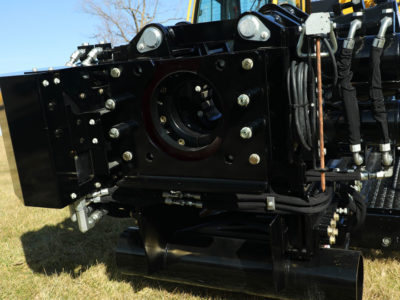Maximize your crew’s productivity by spending less time making and breaking drill rod connections
What’s the difference between an HDD with a 20-foot (6.1-meter) rod rack and one with a 30-foot (9.1-centimeter) rod rack? The answer “10 feet (3.1 meters)” is only partially correct because it doesn’t account for jobsite logistics tied to the length of the rods used. The detailed answer is “making fewer wireline connections and rod exchanges can save countless hours in labor” as well as drill-rod and steering-hand expenses.
If those benefits sound good to you, you will want to check out this article to read about all the features built into the Vermeer D220x500 S3 HDD: Meet the Versatile Vermeer D220x500 S3 Horizontal Directional Drill
Today, though, you’ll learn how the D220x500 S3 HDD outfitted with a 30-foot (9.1-meter) rod rack can help reduce wireline connections on pilot bores. Let’s dive into the details together.
Drill rod investment
In the 200,000-pound (900-kilonewton) drill class, you must consider the out-of-pocket expense of the drill rods in your overall operational costs. It may seem that you should pay more for 30-foot (9.1-meter) rods because they are longer, but that’s not always the case. Here’s why: Rods of this length are considered Range 2 drill pipe because the manufacturing spec allows for random lengths, 27-32 feet (8.2 – 9.8 meters) long.
Range 2 comes from the downhole oil and gas industry. Due to the stringent manufacturing process, random lengths provide significant savings for the manufacturers, and that value is appreciated by the customers as well. The D220x500 S3 with a 30-foot (9.1-meter) rod rack is designed to work with Range 2 pipe to give contractors the flexibility and optimize value in terms of cost-per-foot (meter).
To produce a 20-foot (6.1-meter) drill rod, fabricators have to cut the pipe down to these specific dimensions, and the extra labor and material waste are reflected in the pricing. Of course, if your work involves doing a lot of large-diameter bores in locations where setup space and access space are limited, that extra cost may be worth it because of the additional logistics in trying to accommodate a drill with a longer footprint.
Wireline connections
Choosing the Vermeer D220x500 S3 outfitted with a 30-foot (9.1-meter) rod rack means you won’t need to use as many rods to go the same distance as you would if you were using a drill with a 20-foot (6.1-meter) rack. Fewer drill rods mean fewer rod and wireline connections.
For example, if you use 20-foot (6.1-meter) rods on a 3,000-foot (914.4-meter) bore, your crew will use 150 rods and 150 connections to make the pilot bore. Using 30-foot (9.1-meter) rods, you can reduce your rod and connection count by a third — 33 percent fewer wireline connections to make, 33 percent less rod handling involved.
Steering hand costs
You’re likely not new to large-diameter HDD work if you’ve read this far. You know that threading and splicing a strand of insulated copper wire through each drill rod takes time. Meanwhile, the drill operator’s and steering hand’s work can’t continue until the crew makes the connections. And, unless you have your own internal steering hand and the magnetic, inertial or gyroscopic guidance system, you’re paying someone else to be on the job with your crew. So, in many cases, your crew’s efficiency can have a direct impact on your operational costs for steering hand services.
Reducing the number of wireline connections required on a bore minimizes the amount of labor involved in making those connections and idle time for the drill operator and steering hand.
Adding it up
As you can see, productivity and efficiency savings can add up when you choose the D220x500 S3 with a 30-foot (9.1-meter) rod rack to perform long bores. However, there is a growing market for larger and longer HDD installations with very minimal space. In these situations, the 20-foot (6.1-meter) option may be ideal from a power-to-footprint perspective.
To learn more about the other important features built into the powerful Vermeer D220x500 S3 HDD, check out the following informative links.
- Walkaround of the D220x500 S3 horizontal directional drill by Vermeer
- Vermeer D220x500 S3 HDD features and specs
Contact your local Vermeer dealer for more information about Vermeer horizontal directional drilling equipment.
Vermeer Corporation reserves the right to make changes in engineering, design and specifications; add improvements; or discontinue manufacturing at any time without notice or obligation. Equipment shown is for illustrative purposes only and may display optional accessories or components specific to their global region. Please contact your local Vermeer dealer for more information on machine specifications.
Vermeer and the Vermeer logo are trademarks of Vermeer Manufacturing Company in the U.S. and/or other countries. © 2022 Vermeer Corporation. All Rights Reserved.
